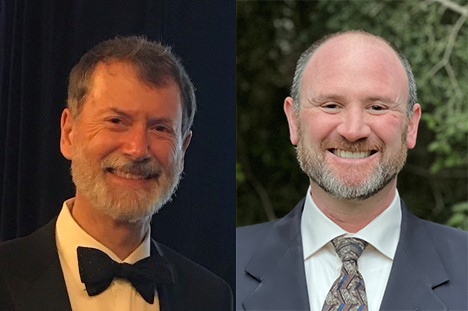Hybrid Examiner Model Works for MP, RO Orals
By Geoffrey S. Ibbott, PhD, ABR Associate Executive Director for Medical Physics, and Michael Yunes, MD, ABR Associate Executive Director for Radiation Oncology
2023;16(3):7
 The ABR continues to evolve its oral exam platform. This spring, oral examiners conducted exams from Tucson as well as from remote locations, resulting in the first “hybrid” exams.
The ABR continues to evolve its oral exam platform. This spring, oral examiners conducted exams from Tucson as well as from remote locations, resulting in the first “hybrid” exams.
In April, approximately 50 medical physics examiners assembled in the test center at ABR headquarters in Tucson. Another 30 examiners joined from their homes or offices. In May, the experience was repeated with radiation oncology exams, which included 50 in-person and 40 remote examiners.
All candidates remained remote and connected to the exam platform from their homes or offices, as they have done for the past two years.
The benefits of the hybrid experience were immediate: examiners who wanted to participate but were unable or unwilling to travel were able to conduct the exams as they had in the past by using the remote tools. Examiners who were interested and able to travel met in Tucson, where they conducted the exams in the same manner but using the ABR’s computer equipment. When not examining, examiners congregated in either a physical or virtual break room, where they were able to chat with colleagues and share experiences (although by policy, specific candidates are never discussed in the break room).
New examiners were required to attend in Tucson, where they could receive hands-on training from the trustees and experienced examiners and could receive constructive critiques on their exam methods during breaks. This interaction was seen as extremely valuable by the new and experienced examiners. The trustees and AED observed all examiners, as has always been the case, and were able to provide feedback in person to examiners on site in Tucson, or by a private conversation in the virtual break room for examiners who were remote.
The exam used the ABR’s new exam platform, “Orals 2.0,” which contained numerous improvements over the earlier version. The most visible, and most highly appreciated, improvement was the integration of the audio and video function directly into the platform. This meant that neither examiners nor candidates needed to run Webex in addition to the exam software, as was the case in the past. Another goal was to ensure that from the candidate end, the examinees could not identify which examiners were in Tucson and which were remote.
Improvements and enhancements have been made between each exam delivery. Connectivity and training issues experienced in the medical physics exam had been resolved by the time the radiation oncology exam was delivered. In addition, a live dashboard was available during the RO exam for the AED to monitor examiner scoring and comments during the exam. This enabled any obvious scoring inconsistencies to be addressed immediately, rather than waiting until after the entire exam had been delivered and reports generated.
Overall, the transition to the “hybrid” exam has been a tremendous success and proof that the ABR, the Board of Governors, and the Board of Trustees listen to and act on the recommendations from diplomates and candidates. Everyone involved should be proud of these accomplishments and excited for the continued development of this process.



